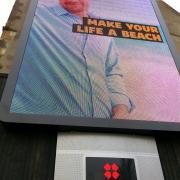
Richard Rennie, an Easter Road resident, has written to councillors and the Council’s Planning Department objecting to Forrest Group Ltd’s application for retrospective consent to an internally illuminated digital display advertisement at 10 Croall Place (Ref. 14/00624/ADV).
It amends a previous, successful application for a similar but smaller hoarding (Ref. 13/00692/ADV).
In its 2013 Report on that application, the Council noted that:
'The proposed static advertising display is unlikely to be any more distracting to motorists than other elements of the surrounding built and natural environment.
'Transport has raised no objections to the proposal on road safety grounds.
'The proposals comply with the relevant Non-statutory guidelines and there are no material considerations which outweigh this conclusion.'
In recommending consent for a limited, 5-year period, the Report also gave as a reason:
'In order to give due recognition to the element of significant change that this location is presently undergoing, and to enable the planning authority to exercise appropriate control at the expiry of those circumstances’.

The steel and aluminium box structure and frame of the originally consented display unit measured 5,400mm wide by 7,900mm high by 500mm deep.
What actually appeared in October, however, measured 6,360mm wide by 9,240mm high and 400mm deep. The reason for it being bigger than was consented, wrote Forrest’s Paul Flynn in a letter to City Development last month, was ‘unforeseen circumstances during the procurement process resulting in the switch to a more efficient but different tile size. Dimensions are the closest possible to maintain correct proportions’.
Comparing Forrest’s original photomontage of the 2013 proposal with what appeared in reality is a bit of an eye-opener. The current application prefers to use architectural drawings rather than a like-for-like photomontage.
Rennie originally contacted the Council in mid-October 2013, when the structure first appeared. His concerns about the hours, intensity and extent of illumination were then referred to Enforcement. Despite subsequent assurances, he has noticed little change since apart from operating hours reducing from 24 hours per day to the consented 16 hours per day (7am–11pm).
Council staff emailed him again recently to say that the developer had lodged a retrospective application. Rennie’s renewed objections are summarised below.

Drivers, Rennie says, risk being distracted by the larger screen on the approach to a busy junction used by children on foot travelling to and from local schools. Whilst accepting that every case is different, he cites the Reporter's decision in DPEA Appeal reference ADA-230-188 (relating to an appeal against the decision by the City of Edinburgh Council Application 12/04245/ADV to refuse advertisement consent):
‘... The road junction is extremely busy, particularly so during morning and evening peak travelling times, and there is no doubt that drivers need to fully concentrate to manoeuvre or react to the manoeuvres of others. This can be more demanding during the hours of darkness when the proposal would be illuminated, therefore more prominent, and be viewed together with a road directional sign. I am therefore satisfied that the proposal would represent an unacceptable increase in the potential for driver distraction at this locus and therefore contrary to the interests of public safety.’

The Croall Place proposal – significantly larger and positioned higher than was originally consented – is, says Rennie, having a detrimental impact on the visual amenity and character of the residential area due to inappropriate size, illumination and prominent location.
He objects to what he sees as damage to the City’s ‘inspiring skyline’, since the structure obtrudes above the roof level of the houses opposite and sends out 'pulsating, colourful beams' which are visible far and wide across eastern Edinburgh.
‘It would be a very simple, desirable and dare I say it a "neighbourly" and proportionate exercise on the part of the developer to unbolt the screen and re-bolt it at a lower level. All that would be lost to the developer would be an equivalent of 1.5 metres of its own branding plate (labelled on the plans submitted as "Feature cladding with illuminated logo") comprising the lowest 2.95 metres of the structure and which is used predominantly, I would envisage, to conceal cables and satisfy the developers own aesthetic (sic) and self-serving promotional aspirations.’
Adequate process and new controls
Rennie is concerned about whether there has been adequate Council scrutiny of such digital advertising applications of late, and whether a sufficiently robust system exists to prevent their promoters riding roughshod over the City.
He wants the Council to stick by Planning Convener Ian Perry's public assurances that the Council would not allow Edinburgh to be turned into Times Square or Piccadilly Circus, and Perry's assessment that contrtols are needed because without them people will push the boundaries as far as they will go.
‘This developer certainly falls into the latter category,’ says Rennie, ‘and there is an opportunity here for Planning to reinforce Mr Perry's clear message that ... developers ... are very welcome to play in Edinburgh's playground, but on Edinburgh's terms.’
What do you think about all this? Should we be concerned about safety and aesthetic concerns, or is the temporary presence of the structure a good enough reason to let it remain? Write and tell us by email spurtle@hotmail.co.uk Facebook Broughton Spurtle or Twitter @theSpurtle